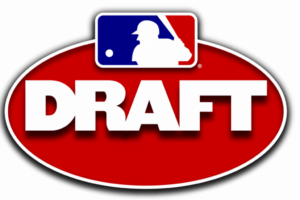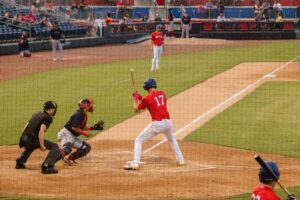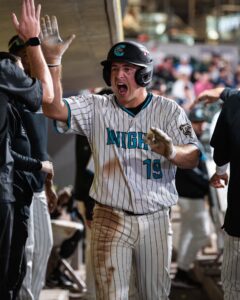Season in Review: 2017 Winston-Salem Dash
Team: Winston-Salem Dash
League: Carolina League (Advanced A)
Final record: 56-84 overall (24-46 1st half, 32-38 2nd half)
Final placement: 5th in 1st half, 4th in 2nd half in the Southern Division (no playoffs)
Complete Team Stats
Before the Dash played a game in 2017, their roster appeared to have some strong pitching but perhaps lacked offensive punch. Things played out that way in the first half, but the team was reinvigorated with the addition of some key prospects (including some guy named Eloy) in the second half. It wasn’t enough to get a playoff spot, but Dash fans had to be happy to see some marked improvement.
Despite the poor overall record, there were a number of impressive individual performances, and not just from the most highly-touted prospects.
Position Players
The backstops proved to be a strong suit for the Dash. Zack Collins drew some concerns early in the season while hovering around a .200 average and struggling a bit with a swing hitch. But he caught fire posting an 1.148 OPS in his last dozen games in High-A before being promoted to AA Birmingham. He drew walks at a prolific rate throughout the year (18.5%), continued to improve his defense and hit 17 long balls in 101 games for Winston-Salem (and 2 more with Birmingham). Despite the presence of the club’s key catching prospect, Seby Zavala forced his way onto the team and showed he was more than ready for the jump, posting a .302/.376/.485 line in 55 games in High-A. He led the entire White Sox farm system in home runs with 21 combined between Kannapolis and Winston-Salem.
In case you didn’t hear, the White Sox acquired another wave of significant prospects this summer, many of whom played in Winston-Salem. Eloy Jimenez of course stands out being one of the best prospects in baseball, and sure enough he had no trouble whatsoever against High-A pitching – can I interest you in a .345/.410/.685 line with 8 home runs in just 29 games? First baseman Matt Rose was a new contributor as well, adding his .811 OPS in 36 games to help the team improve.
It looked coming in like the Dash would benefit from some of the outfield bats, but an ever-changing cast of men playing in the grass had various degrees of struggles. Luis Alexander Basabe‘s prospect stock may have taken a hit after an injury-pocked campaign that ended with a .221/.320/.320 line, but given his age (20 for most of the season) and missed time it could be just a speed bump. Joel Booker joined the club in mid-June after a blazing start with Kannapolis, but could only muster a .581 OPS against Carolina League pitching. Jameson Fisher, considered a polished hitter for the level, contributed a middling .707 OPS, though he did see the power numbers spike a bit with seven round trippers in 64 games.
Then there’s Danny Mendick, who in a years time went from org-wide bench bat to starter to league All-Star to the edge of the prospect radar. He did a bit of everything well in 84 games with the Dash: hitting .289 with a .373 OBP, showing some power with 7 homers, stealing 11 bases in 15 tries, and playing excellent defense at both middle infield positions. He was promoted to AA in August. You can learn more about the 23-year-old pop-up prospect in our feature here.
Pitchers
Alec Hansen made only 11 starts for the Dash, but he made quite an impression. The ultra-tall right-hander posted a 2.93 ERA by throwing strikes (3.9 BB/9) and still avoiding hard contact (6.5 H/9), and you want to talk about strikeouts? His rate with the Dash was 12.7 per nine innings, and on the full season his 191 whiffs was the most for any pitcher in the minors… since 2011. He was pretty good at baseball, as Dash radio man Brian Boesch likes to say.
Dane Dunning had a damn good season of his own. Joining the team after four utterly dominant starts with Kanny, Dunning posted a 3.45 ERA in 22 outings for Winston-Salem, paired with strong peripherals (2.7 BB/9, 10.3 K/9) in a breakout campaign. Bernardo Flores also joined the team with a midseason promotion, and while the lefty wasn’t as dominant as Dunning, he acquitted himself well for a relatively raw and young-for-level 21-year-old: 4.24 ERA in nine starts. Fellow lefty Tanner Banks is in some ways the opposite as an older, more polished starter, but he breezed through 14 starts with a 3.05 ERA before his promotion to Birmingham.
There was also a wave of new arms in the system who spent time with the Dash, results varied. Ian Clarkin made just three high wire act starts, posting a 2.45 ERA despite walking eight and striking out just five in 11 innings. A.J. Puckett got the nod five times, to the tune of a 4.28 ERA. Reliver Ryan Burr may have had the best showing of the new guys, as shown in this line in his six games: 8.1 IP, 5 H, 0 ER, 5 BB, 13 K.
Speaking of relievers and Burr, Ryan dueled with Ian Hamilton for the honor of best bullpen arm on the team. His early season promotion to Birmingham may have been premature, but with the Dash he struck out a batter an inning while walking just 1.4 batters per nine in his 52.2 innings in Advanced A-ball. In the end though they may both have been bested by a guy who retired last year at the ripe old age of 21 before coming back in 2017. Matt Foster‘s numbers with the Dash: 14.1 IP, 8 H, 3 ER, 2 BB, 19 K (and that was after even more dominant numbers in Kannapolis). We did a feature on Foster recently too, which you can read here.
Want to know right away when we publish a new article? Type your email address in the box on the right-side bar (or at the bottom, if on a mobile device) and click the “create subscription” button. Our list is completely spam free, and you can opt out at any time.







I think a more comprehensive analysis of players who play CF, C and SS should include defensive metrics/ stats. Thanks.
I think you mistook a “Season in Review” of an entire team in one article, for a deep prospect analysis. This is the former.
Also you seem to assume that defensive stats from the minors are useful in such an analysis. They really aren’t. They are barely useful in the majors. In the minors there are dramatically fewer data points collected, the playing conditions and roles are skewed, and the players are by nature early in their development. There is little value in defensive stats from the minors, unless or until they start going full Trackman-level with public stats. Even then it’s utility will still be limited.